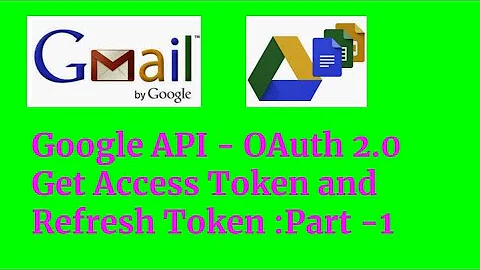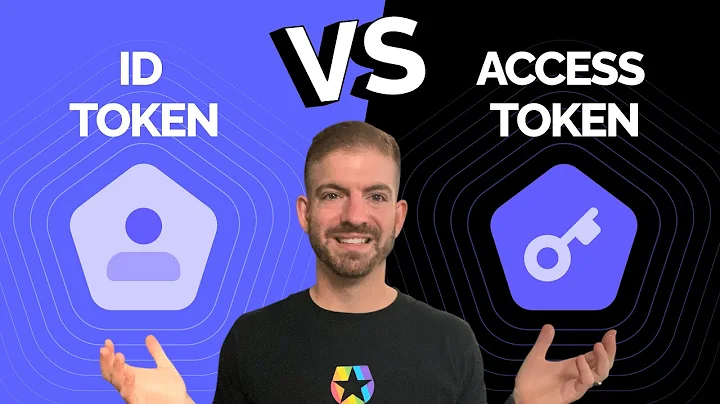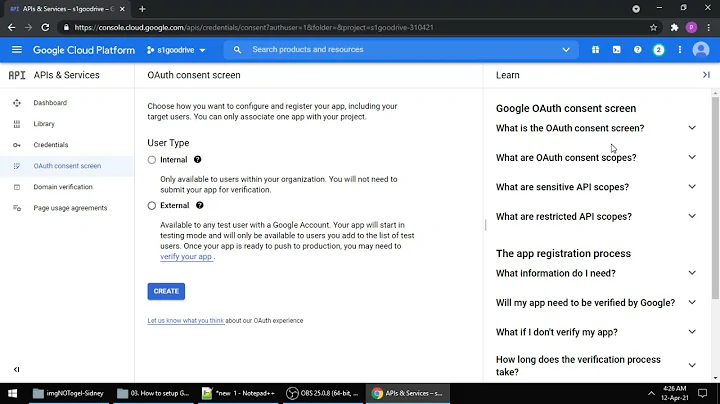Validate Google Id Token
Solution 1
There are a couple of different ways in which you can validate the integrity of the ID token on the server side:
- "Manually" - constantly download Google's public keys, verify signature and then each and every field, including the
issone; the main advantage (albeit a small one in my opinion) I see here is that you can minimize the number of requests sent to Google. - "Automatically" - do a GET on Google's endpoint to verify this token
https://www.googleapis.com/oauth2/v3/tokeninfo?id_token={0} - Using a Google API Client Library - like the official one.
Here's how the second one could look:
private const string GoogleApiTokenInfoUrl = "https://www.googleapis.com/oauth2/v3/tokeninfo?id_token={0}";
public ProviderUserDetails GetUserDetails(string providerToken)
{
var httpClient = new MonitoredHttpClient();
var requestUri = new Uri(string.Format(GoogleApiTokenInfoUrl, providerToken));
HttpResponseMessage httpResponseMessage;
try
{
httpResponseMessage = httpClient.GetAsync(requestUri).Result;
}
catch (Exception ex)
{
return null;
}
if (httpResponseMessage.StatusCode != HttpStatusCode.OK)
{
return null;
}
var response = httpResponseMessage.Content.ReadAsStringAsync().Result;
var googleApiTokenInfo = JsonConvert.DeserializeObject<GoogleApiTokenInfo>(response);
if (!SupportedClientsIds.Contains(googleApiTokenInfo.aud))
{
Log.WarnFormat("Google API Token Info aud field ({0}) not containing the required client id", googleApiTokenInfo.aud);
return null;
}
return new ProviderUserDetails
{
Email = googleApiTokenInfo.email,
FirstName = googleApiTokenInfo.given_name,
LastName = googleApiTokenInfo.family_name,
Locale = googleApiTokenInfo.locale,
Name = googleApiTokenInfo.name,
ProviderUserId = googleApiTokenInfo.sub
};
}
GoogleApiTokenInfo class:
public class GoogleApiTokenInfo
{
/// <summary>
/// The Issuer Identifier for the Issuer of the response. Always https://accounts.google.com or accounts.google.com for Google ID tokens.
/// </summary>
public string iss { get; set; }
/// <summary>
/// Access token hash. Provides validation that the access token is tied to the identity token. If the ID token is issued with an access token in the server flow, this is always
/// included. This can be used as an alternate mechanism to protect against cross-site request forgery attacks, but if you follow Step 1 and Step 3 it is not necessary to verify the
/// access token.
/// </summary>
public string at_hash { get; set; }
/// <summary>
/// Identifies the audience that this ID token is intended for. It must be one of the OAuth 2.0 client IDs of your application.
/// </summary>
public string aud { get; set; }
/// <summary>
/// An identifier for the user, unique among all Google accounts and never reused. A Google account can have multiple emails at different points in time, but the sub value is never
/// changed. Use sub within your application as the unique-identifier key for the user.
/// </summary>
public string sub { get; set; }
/// <summary>
/// True if the user's e-mail address has been verified; otherwise false.
/// </summary>
public string email_verified { get; set; }
/// <summary>
/// The client_id of the authorized presenter. This claim is only needed when the party requesting the ID token is not the same as the audience of the ID token. This may be the
/// case at Google for hybrid apps where a web application and Android app have a different client_id but share the same project.
/// </summary>
public string azp { get; set; }
/// <summary>
/// The user's email address. This may not be unique and is not suitable for use as a primary key. Provided only if your scope included the string "email".
/// </summary>
public string email { get; set; }
/// <summary>
/// The time the ID token was issued, represented in Unix time (integer seconds).
/// </summary>
public string iat { get; set; }
/// <summary>
/// The time the ID token expires, represented in Unix time (integer seconds).
/// </summary>
public string exp { get; set; }
/// <summary>
/// The user's full name, in a displayable form. Might be provided when:
/// The request scope included the string "profile"
/// The ID token is returned from a token refresh
/// When name claims are present, you can use them to update your app's user records. Note that this claim is never guaranteed to be present.
/// </summary>
public string name { get; set; }
/// <summary>
/// The URL of the user's profile picture. Might be provided when:
/// The request scope included the string "profile"
/// The ID token is returned from a token refresh
/// When picture claims are present, you can use them to update your app's user records. Note that this claim is never guaranteed to be present.
/// </summary>
public string picture { get; set; }
public string given_name { get; set; }
public string family_name { get; set; }
public string locale { get; set; }
public string alg { get; set; }
public string kid { get; set; }
}
Solution 2
According to this github issue, you can now use GoogleJsonWebSignature.ValidateAsync method to validate a Google-signed JWT. Simply pass the idToken string to the method.
var validPayload = await GoogleJsonWebSignature.ValidateAsync(idToken);
Assert.IsNotNull(validPayload);
If it is not a valid token, it will return null.
Note that to use this method, you need to install Google.Apis.Auth nuget firsthand.
Solution 3
Google states in the documentation for openId connect
For debugging purposes, you can use Google’s tokeninfo endpoint. Suppose your ID token’s value is XYZ123.
You should not be using that endpoint to validate your JWT.
Validation of an ID token requires several steps:
- Verify that the ID token is properly signed by the issuer. Google-issued tokens are signed using one of the certificates found at the URI specified in the jwks_uri field of the discovery document.
- Verify that the value of iss in the ID token is equal to https://accounts.google.com or accounts.google.com.
- Verify that the value of aud in the ID token is equal to your app’s client ID.
- Verify that the expiry time (exp) of the ID token has not passed.
- If you passed a hd parameter in the request, verify that the ID token has a hd claim that matches your G Suite hosted domain.
There is an official sample project on how to validate them here. Unfortunately we have not added this to the Google .Net Client library yet. It has been logged as an issue
Solution 4
I think it is worth mentioning that you can authenticate using @Alexandru Marculescu answer, but there is a note in the documentation to not use method 2.
Per the documentation under Calling the tokeninfo endpoint (which has changed to https://oauth2.googleapis.com/tokeninfo?id_token=XYZ123)
It is not suitable for use in production code as requests may be throttled or otherwise subject to intermittent errors.
The recommended way to validate the idToken is to call a Google API Client Library. This is how I perform the validation check
using Google.Apis.Auth;
...
public async Task<GoogleJsonWebSignature.Payload> ValidateIdTokenAndGetUserInfo(string idToken)
{
if (string.IsNullOrWhiteSpace(idToken))
{
return null;
}
try
{
return await GoogleJsonWebSignature.ValidateAsync(idToken);
}
catch (Exception exception)
{
_Logger.LogError(exception, $"Error calling ValidateIdToken in GoogleAuthenticateHttpClient");
return null;
}
}
Solution 5
So, what I found is that as the OpenIDConnect specs have a /.well-known/ url that contains the information that you need to validate a token. This includes access to the public keys for the signature. The JWT middleware forms that .well-known url from the authority, retrieves the information, and proceeds to validate it on it's own.
The short answer to the question is that the validation is already happening in the middleware, there's nothing left to do.
Related videos on Youtube
Comments
-
Darthg8r about 2 years
I'm using ASP.NET Core to serve an API to an Android client. Android signs in as a Google account and passes a JWT, the ID Token, to API as a bearer token. I have the app working, it does pass the auth checks, but I don't think it's validating the token signature.
Per Google's documents, I can call this url to do it: https://www.googleapis.com/oauth2/v3/tokeninfo?id_token=XYZ123, but I can't find the appropriate hooks on the server side to do it. Also according to the Google docs, I can somehow use the Client Access APIs to do it without calling to the server every time.
My configuration code:
app.UseJwtBearerAuthentication( new JwtBearerOptions() { Authority = "https://accounts.google.com", Audience = "hiddenfromyou.apps.googleusercontent.com", TokenValidationParameters = new TokenValidationParameters() { ValidateAudience = true, ValidIssuer = "accounts.google.com" }, RequireHttpsMetadata = false, AutomaticAuthenticate = true, AutomaticChallenge = false, });How do I get the JWTBearer middleware to validate the signature? I'm close to giving up on using the MS middleware and rolling my own.
-
 DaImTo about 7 yearsWow I have been a contributor on the Official Google .Net client library since 2012. Are you sure C# doesn't have one yet? Also spamming the tokeninfo is not recommend by Google you should validate the Token_id locally. github.com/google/google-api-dotnet-client
DaImTo about 7 yearsWow I have been a contributor on the Official Google .Net client library since 2012. Are you sure C# doesn't have one yet? Also spamming the tokeninfo is not recommend by Google you should validate the Token_id locally. github.com/google/google-api-dotnet-client -
 Alexandru Marculescu about 7 yearsapologies @DalmTo, you're right! I've edited my answer
Alexandru Marculescu about 7 yearsapologies @DalmTo, you're right! I've edited my answer -
Bob Black over 6 yearsWhere is GoogleApiTokenInfo defined? Is this a custom class you've created, or defined in the Google SDK?
-
 Alexandru Marculescu over 6 years@BobBlack - I've updated my answer to include it; it's created as per Google's specs
Alexandru Marculescu over 6 years@BobBlack - I've updated my answer to include it; it's created as per Google's specs -
 jfbloom22 about 6 yearsFor those building a Chrome Extension or Chrome App, the
jfbloom22 about 6 yearsFor those building a Chrome Extension or Chrome App, thechrome.identity.getAuthToken()method only provides anaccess_token. Fortunately the endpoint @AlexandruMarculescu suggests in option 2 supports verifying this type of token as well: googleapis.com/oauth2/v3/tokeninfo?access_token={0} -
 icelic over 4 yearsPer docs, this doesn't return null when token is invalid. It throws InvalidJwtException so instead of asserting or checking for null you need to use try catch.
icelic over 4 yearsPer docs, this doesn't return null when token is invalid. It throws InvalidJwtException so instead of asserting or checking for null you need to use try catch. -
LW001 about 4 yearsWhile this code may answer the question, providing additional context regarding why and/or how this code answers the question improves its long-term value.
-
Loveneet Chahal about 4 yearsActually my concern is to post this answer to clarify that user can validate the token provided by front-end developer for google login, or by using this code user can validate and get user details from the token. further by using this they can generate their own token using jwt.
-
 Amin Mir almost 3 yearsThe takeninfo endpoint can be used to validate JWT and it checks
Amin Mir almost 3 yearsThe takeninfo endpoint can be used to validate JWT and it checksissandexpto have expected value and also checks the signature to verify it. Sign in with google -
 Admin about 2 yearsAs it’s currently written, your answer is unclear. Please edit to add additional details that will help others understand how this addresses the question asked. You can find more information on how to write good answers in the help center.
Admin about 2 yearsAs it’s currently written, your answer is unclear. Please edit to add additional details that will help others understand how this addresses the question asked. You can find more information on how to write good answers in the help center. -
John V about 2 yearsIf you have a new question, please ask it by clicking the Ask Question button. Include a link to this question if it helps provide context. - From Review








